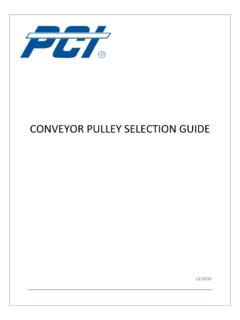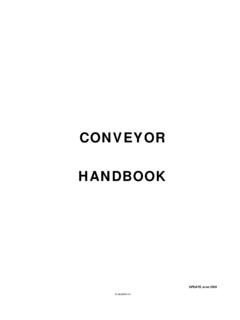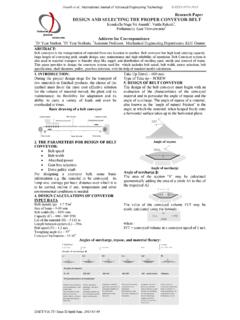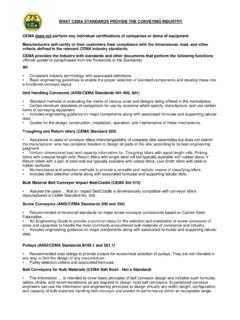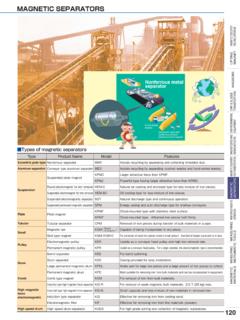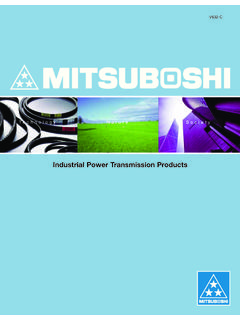Transcription of Drive Pulley Lagging -- the importance of proper technical ...
1 Drive Pulley Lagging The importance of proper technical Analysis and selection Presented at the 2010 Annual SME Meeting in Phoenix, AZ Paul Ormsbee, Allen V. Reicks Overland Conveyor Company, Inc. Lakewood, CO ABSTRACT A follow-up paper to Ceramic Lagging A Good Thing Can Be Costly if Misused presented at the 2006 annual meeting. The performance of Drive Pulley Lagging has become much more important in recent years due to higher torque drives, higher conveyor belt speeds, and the use of ceramic Lagging .
2 The popularity of ceramic Lagging is due to the reduced risk of Drive Pulley slip and reduction of Lagging wear. However, the application of ceramic Lagging to a Pulley can lead to Lagging failure of costly wear to the belt; the most expensive component on the conveyor. Modern analysis and simulation tools and a better understanding of how Lagging and belting interact during torque transmission are necessary for a modern conveyor designer to select this relatively inexpensive but important component.
3 Case studies will be presented as well as analysis techniques. INTRODUCTION There are a few basic reasons for the application of Lagging to both driven and non-driven pulleys . Lagging serves as a protective layer guarding the Pulley from premature failure due to abrasion. While protecting the Pulley , the Lagging can also protect the conveyor belting from a similar sort of wear failure caused by abrasion. Lagging can also creates an increase in friction between the Pulley and the belt which is usually needed when there is a requirement for torque transfer through the Pulley to the belt.
4 Lagging is applied to nearly all conveyors to address at least one (if not all) of the basic points above. In addition to performing the points listed above, Lagging should be applied in a way that the Lagging itself does not wear prematurely due to abrasion, or delaminating from the Pulley , as well as cause belt wear. Now, the application of Lagging onto conveyors with smaller belt tensions and lower Drive torques is, in many ways, a more simple process than properly applying Lagging onto a conveyor with high belt tensions, and high Drive torques.
5 Lagging applied to smaller conveyors tends to be selected based off an economical selection criterion and later evaluated on whether failures occur. Because of the lower tensions and torques (and relatively thick Lagging ), failures are not common and the Lagging is effective. However, with the higher Drive torques and belt tensions seen in many of today s applications, Lagging can no longer be safely selected solely from an economical selection criterion without the significant risk of failure for the more expensive conveyor components on a high torque/high tension conveyor.
6 In general, when slipping, Lagging abrasion rate (and in the same way, belt bottom cover abrasion rate) is proportional to the contact pressure between the belt and the Pulley face (Metlikovic (1996)). In other words, higher torques and higher tensions result in an increase in abrasion risk on Pulley Lagging and bottom belt cover. This is especially true with ceramic Lagging . This paper will discuss how it is important analyze the effect that Lagging design has upon each of the three basic reasons for the application of Lagging on high torque conveyors as well as the effect the Lagging design has on the relative expected life of the Lagging .
7 Analysis methods will be discussed, and examples will be given to illustrate the application of the analysis methods. It should be noted that this is a state of the development paper. FAILURE AND ITS CAUSES Before analysis methods can be discussed it is important to understand what the ultimate goal of these analyses might be. For the purpose of this paper, analysis is used to gain insight into: The premature failure of both rubber and ceramic Lagging due to abrasion and/or the delamination of the Lagging from the Pulley .
8 The potential for Lagging to cause damage to other conveyor components (specifically the bottom cover of the belt). Two determining factors as to whether high torque applications of Pulley Lagging will cause either of the points listed above are localized slip (which causes abrasion) and excessive internal stress/strain within the Lagging which may result in the delaminating of the Pulley Lagging . Metlikovic (1996) showed that nearly 75% of failed pulleys fail due to abrasion , and furthermore that, Abrasion failure is a complex problem and can not be solved only by improving the abrasion resistance of the Lagging material.
9 How does one predict abrasion and calculate internal stresses and strains? An understanding of abrasion tells us that abrasion happens when materials rub and slip against each other; so if we can predict any rubbing or slipping that occurs between the belt and the Lagging we can predict where abrasion might occur and subsequently adjust our design such that the predicted slipping is mitigated. As for prediction of internal stresses, modern day Finite Element Analysis is a useful tool that can accurately predict the magnitude of stresses/strains within a Lagging model.
10 Now, it is not entirely clear the upper allowable limit of stress or strain within Lagging before Lagging mechanical failure occurs or how much localized slip accelerates the wear of the belt cover and/or Pulley Lagging . We do however know from experience that if localized slip or high stress/strain is left unaddressed there is significant risk towards accelerated Lagging or belt cover failure, especially in high torque applications. Figure 1 Picture of a failed Lagging application showing both Lagging abrasion and delamination Localized Slip Prediction One way of analyzing Lagging design and predicting whether abrasion causing localized slip may happen on a Lagging application is discussed in the paper titled Ceramic Lagging A Good Thing Can Be Costly if Misused by Timothy Mess and Allen V.

